Trends in Global Research on Seed Dispersal: A Bibliometric Analysis
Abstract
:1. Introduction
2. Materials and Methodology
2.1. Data Collection
2.2. Methodology
2.2.1. Bibliometric Analysis Methods
2.2.2. Activity Index (AI) and Attraction Index (AAI)
3. Results and Discussion
3.1. Basic Characteristics of the Literature
3.1.1. Quantity of Articles and Citations
3.1.2. Analysis of Subject Categories
3.1.3. Journal Analysis
3.2. Research Power of Seed Dispersal
3.2.1. Analysis of Countries and Institutions
- (1)
- Quantity of articles and citations
- (2)
- Collaboration network
- (3)
- The development of seed dispersal research in selected countries
3.2.2. Author Analysis
- (1)
- Author collaboration network
- (2)
- Author co-citation network
3.3. Intellectual Base
3.4. Key Research Areas
3.4.1. Keyword Co-Occurrence
3.4.2. Keyword Burst Analysis
3.4.3. Keywords in Different Countries
4. Conclusions and Limitations
- (1)
- The number of publications on seed dispersal research globally increased significantly over time. The number of citations per publication peaked in 2000. The 10 most productive journals accounted for 22.95% of all publications in the field of seed dispersal, and Ecology had the highest impact in this field. Researchers in the field of seed dispersal are mostly from the USA and European countries, and a collaboration network centered on the USA, Spain, Germany, Australia, Britain and France gradually formed.
- (2)
- On the basis of the AI and AAI, we determined that different countries/territories have different research abilities in the field of seed dispersal. The research effort and academic impact of Spain were higher than the global average level in most years. Although the research effort and academic impact of Germany, Brazil, China and Japan were lower than the global average level in most years, their academic impact has continuously increased in recent years. We also found that seed dispersal research was performed by five author groups with outstanding research records.
- (3)
- The burst analysis showed that myrmecochorous is a very important field of seed dispersal research, and new research areas or frontiers have mainly concentrated on seed body size and the ecological network of seed dispersal.
- (4)
- Currently, many studies are limited to only the number of seeds and distance of seed dispersal and do not systematically investigate every process of the seed renewal stage (seed production, seed dispersal, seed germination, seedling settlement, seedling establishment, etc.). As the monitoring of seed germination and seedling growth in the later stages of seed dispersal is time-consuming and labor-intensive, relevant research is still lacking. In addition, too much attention has been given to the negative impacts of human interference on the spread of seeds by animals, and the beneficial aspects of human interference in the process of seed dispersal have been ignored [46]. Finally, the development of mathematical models related to seed dispersal has created an opportunity to study the processes of seed dispersal and its potential consequences.
Supplementary Materials
Author Contributions
Funding
Data Availability Statement
Acknowledgments
Conflicts of Interest
References
- Proctor, V.W. Long-Distance Dispersal of Seeds by Retention in Digestive Tract of Birds. Science 1968, 160, 321–322. [Google Scholar] [CrossRef] [PubMed]
- Howe, H.F. Chapter 4—Seed Dispersal by Fruit-Eating Birds and Mammals. In Seed Dispersal; Murray, D.R., Ed.; Academic Press: San Diego, CA, USA, 1986; pp. 123–189. [Google Scholar]
- Tackenberg, O.; Poschlod, P.; Bonn, S. Assessment of Wind Dispersal Potential in Plant Species. Ecol. Monogr. 2003, 73, 191–205. [Google Scholar] [CrossRef]
- Kowarik, I.; Säumel, I. Water dispersal as an additional pathway to invasions by the primarily wind-dispersed tree Ailanthus altissima. Plant Ecol. 2008, 198, 241–252. [Google Scholar] [CrossRef]
- Butler, D.W.; Green, R.J.; Lamb, D.; McDonald, W.J.F.; Forster, P.I. Biogeography of seed-dispersal syndromes, life-forms and seed sizes among woody rain-forest plants in Australia’s subtropics. J. Biogeogr. 2007, 34, 1736–1750. [Google Scholar] [CrossRef]
- Byrne, M.M.; Levey, D.J. Removal of seeds from frugivore defecations by ants in a Costa Rican rain forest. Vegetatio 1993, 107, 363–374. [Google Scholar] [CrossRef]
- Campos-Arceiz, A.; Blake, S. Megagardeners of the forest—The role of elephants in seed dispersal. Acta Oecol. 2011, 37, 542–553. [Google Scholar] [CrossRef]
- Saatkamp, A.; Cochrane, A.; Commander, L.; Guja, L.K.; Jimenez-Alfaro, B.; Larson, J.; Nicotra, A.; Poschlod, P.; Silveira, F.A.O.; Cross, A.T.; et al. A research agenda for seed-trait functional ecology. New Phytol. 2019, 221, 1764–1775. [Google Scholar] [CrossRef] [Green Version]
- Liu, Z.; Zhao, M.; Lu, Z.; Zhang, H. Seed Traits Research Is on the Rise: A Bibliometric Analysis from 1991–2020. Plants 2022, 11, 2006. [Google Scholar] [CrossRef]
- Camargo, P.H.S.A.; Rodrigues, S.B.M.; Piratelli, A.J.; Oliveira, P.S.; Christianini, A.V. Interhabitat variation in diplochory: Seed dispersal effectiveness by birds and ants differs between tropical forest and savanna. Perspect. Plant Ecol. Evol. Syst. 2019, 38, 48–57. [Google Scholar] [CrossRef]
- Li, X.; Ma, W.; Xing, F. A review of seed ecology of poisonous plants in the world’s grasslands. Acta Oecol. 2021, 110, 103711. [Google Scholar] [CrossRef]
- Fuzessy, L.F.; Janson, C.; Silveira, F.A.O. Effects of seed size and frugivory degree on dispersal by Neotropical frugivores. Acta Oecol. 2018, 93, 41–47. [Google Scholar] [CrossRef]
- Wang, Z.; Zhao, Y.; Wang, B. A bibliometric analysis of climate change adaptation based on massive research literature data. J. Clean. Prod. 2018, 199, 1072–1082. [Google Scholar] [CrossRef]
- Liu, W.; Wang, J.; Li, C.; Chen, B.; Sun, Y. Using Bibliometric Analysis to Understand the Recent Progress in Agroecosystem Services Research. Ecol. Econ. 2019, 156, 293–305. [Google Scholar] [CrossRef]
- Boyack, K.W. Mapping knowledge domains: Characterizing PNAS. Proc. Natl. Acad. Sci. USA 2004, 101, 5192–5199. [Google Scholar] [CrossRef] [PubMed] [Green Version]
- Grames, E.M.; Stillman, A.N.; Tingley, M.W.; Elphick, C.S. An automated approach to identifying search terms for systematic reviews using keyword co-occurrence networks. Methods Ecol. Evol. 2019, 10, 1645–1654. [Google Scholar] [CrossRef]
- Mongeon, P.; Paul-Hus, A. The journal coverage of Web of Science and Scopus: A comparative analysis. Scientometrics 2016, 106, 213–228. [Google Scholar] [CrossRef]
- Nakagawa, S. A farewell to Bonferroni: The problems of low statistical power and publication bias. Behav. Ecol. 2004, 15, 1044–1045. [Google Scholar] [CrossRef]
- Huang, L.; Zhou, M.; Lv, J.; Chen, K. Trends in global research in forest carbon sequestration: A bibliometric analysis. J. Clean. Prod. 2020, 252, 119908. [Google Scholar] [CrossRef]
- Chen, K.; Guan, J. A bibliometric investigation of research performance in emerging nanobiopharmaceuticals. J. Informetr. 2011, 5, 233–247. [Google Scholar] [CrossRef]
- Schubert, A.; Braun, T. Relative indicators and relational charts for comparative assessment of publication output and citation impact. Scientometrics 1986, 9, 281–291. [Google Scholar] [CrossRef]
- Ma, J.; Chen, T.; Ma, X.; Zhang, B.; Zhang, J.; Xu, L.; Wang, Y.; Huang, J.; Liu, Z.; Wang, F.; et al. Comprehensive bibliometric and visualized analysis of research on fecal microbial transplantation published from 2000 to 2021. Biomed. Eng. Online 2022, 21, 78. [Google Scholar] [CrossRef] [PubMed]
- Hu, X.; Rousseau, R. A comparative study of the difference in research performance in biomedical fields among selected Western and Asian countries. Scientometrics 2009, 81, 475. [Google Scholar] [CrossRef]
- Bueno, R.d.S.; García, D.; Galetti, M.; La Mantia, T. Trophic and spatial complementarity on seed dispersal services by birds, wild mammals, and cattle in a Mediterranean woodland pasture. Glob. Ecol. Conserv. 2021, 31, e01880. [Google Scholar] [CrossRef]
- Nelson, A.S.; Whitehead, S.R. Fruit secondary metabolites shape seed dispersal effectiveness. Trends Ecol. Evol. 2021, 36, 1113–1123. [Google Scholar] [CrossRef]
- Wang, B.; Zhang, Q.; Cui, F. Scientific research on ecosystem services and human well-being: A bibliometric analysis. Ecol. Indic. 2021, 125, 107449. [Google Scholar] [CrossRef]
- Liu, X.; Zhang, L.; Hong, S. Global biodiversity research during 1900–2009: A bibliometric analysis. Biodivers. Conserv. 2011, 20, 807–826. [Google Scholar] [CrossRef]
- Lennox, R.; Cooke, S.J. State of the interface between conservation and physiology: A bibliometric analysis. Conserv. Physiol. 2014, 2, cou003. [Google Scholar] [CrossRef]
- Zhao, Y.; Jiang, Y.; Zhou, Z.; Yang, Z. Global trends in karst-related studies from 1990 to 2016: A bibliometric analysis. Alex. Eng. J. 2021, 60, 2551–2562. [Google Scholar] [CrossRef]
- Hirsch, J.E. An index to quantify an individual’s scientific research output. Proc. Natl. Acad. Sci. USA 2005, 102, 16569–16572. [Google Scholar] [CrossRef] [Green Version]
- Glänzel, W.; Danell, R.; Persson, O. The decline of Swedish neuroscience: Decomposing a bibliometric national science indicator. Scientometrics 2003, 57, 197–213. [Google Scholar] [CrossRef]
- Qiu, H.; Chen, Y.-F. Bibliometric analysis of biological invasions research during the period of 1991 to 2007. Scientometrics 2009, 81, 601. [Google Scholar] [CrossRef] [Green Version]
- Schleuning, M.; Fründ, J.; García, D. Predicting ecosystem functions from biodiversity and mutualistic networks: An extension of trait-based concepts to plant–animal interactions. Ecography 2015, 38, 380–392. [Google Scholar] [CrossRef]
- Gallagher, R.; Burnham, M.; Fuerst, E. The Chemical Ecology of Seed Persistence in Soil Seed Banks; CABI International: Wallingford, UK, 2014; pp. 178–203. [Google Scholar]
- Bleher, B.; Böhning-Gaese, K. Consequences of frugivore diversity for seed dispersal, seedling establishment and the spatial pattern of seedlings and trees. Oecologia 2001, 129, 385–394. [Google Scholar] [CrossRef] [PubMed]
- Jordano, P. What is long-distance dispersal? And a taxonomy of dispersal events. J. Ecol. 2017, 105, 75–84. [Google Scholar] [CrossRef] [Green Version]
- Steele, M.A.; Yi, X. Squirrel-Seed Interactions: The Evolutionary Strategies and Impact of Squirrels as Both Seed Predators and Seed Dispersers. Front. Ecol. Evol. 2020, 8, 259. [Google Scholar] [CrossRef]
- Yi, X.; Wang, M.; Xue, C.; Ju, M. Radicle pruning by seed-eating animals helps oak seedlings absorb more soil nutrient. Integr. Zool. 2021, 16, 637–645. [Google Scholar] [CrossRef] [PubMed]
- Rogers, H.S.; Fricke, E.C. Maternal microbes complicate coexistence for tropical trees. Proc. Natl. Acad. Sci. USA 2019, 116, 7166–7168. [Google Scholar] [CrossRef] [Green Version]
- Heleno, R.; Vargas, P. How do islands become green? Glob. Ecol. Biogeogr. 2015, 24, 518–526. [Google Scholar] [CrossRef]
- Correia, M.; Heleno, R.; Vargas, P.; Rodríguez-Echeverría, S. Should I stay or should I go? Mycorrhizal plants are more likely to invest in long-distance seed dispersal than non-mycorrhizal plants. Ecol. Lett. 2018, 21, 683–691. [Google Scholar] [CrossRef]
- Ale Ebrahim, N.; Salehi, H.; Embi, M.A.; Habibi Tanha, F.; Gholizadeh, H.; Motahar, S.M.; Ordi, A. Effective Strategies for Increasing Citation Frequency; University Library of Munich: Munich, Germany, 2013. [Google Scholar]
- Yoshikane, F.; Suzuki, Y.; Arakawa, Y.; Ikeuchi, A.; Tsuji, K. Multiple Regression Analysis between Citation Frequency of Patents and their Quantitative Characteristics. Procedia-Soc. Behav. Sci. 2013, 73, 217–223. [Google Scholar] [CrossRef]
- Tian, X.; Geng, Y.; Sarkis, J.; Zhong, S. Trends and features of embodied flows associated with international trade based on bibliometric analysis. Resour. Conserv. Recycl. 2018, 131, 148–157. [Google Scholar] [CrossRef]
- Zhou, W.; Kou, A.; Chen, J.; Ding, B. A retrospective analysis with bibliometric of energy security in 2000–2017. Energy Rep. 2018, 4, 724–732. [Google Scholar] [CrossRef]
- Zhang, H.X.; Zhou, D.W. Current status in seed ecology. Pratacult. Sci. 2016, 33, 2221–2236. [Google Scholar]
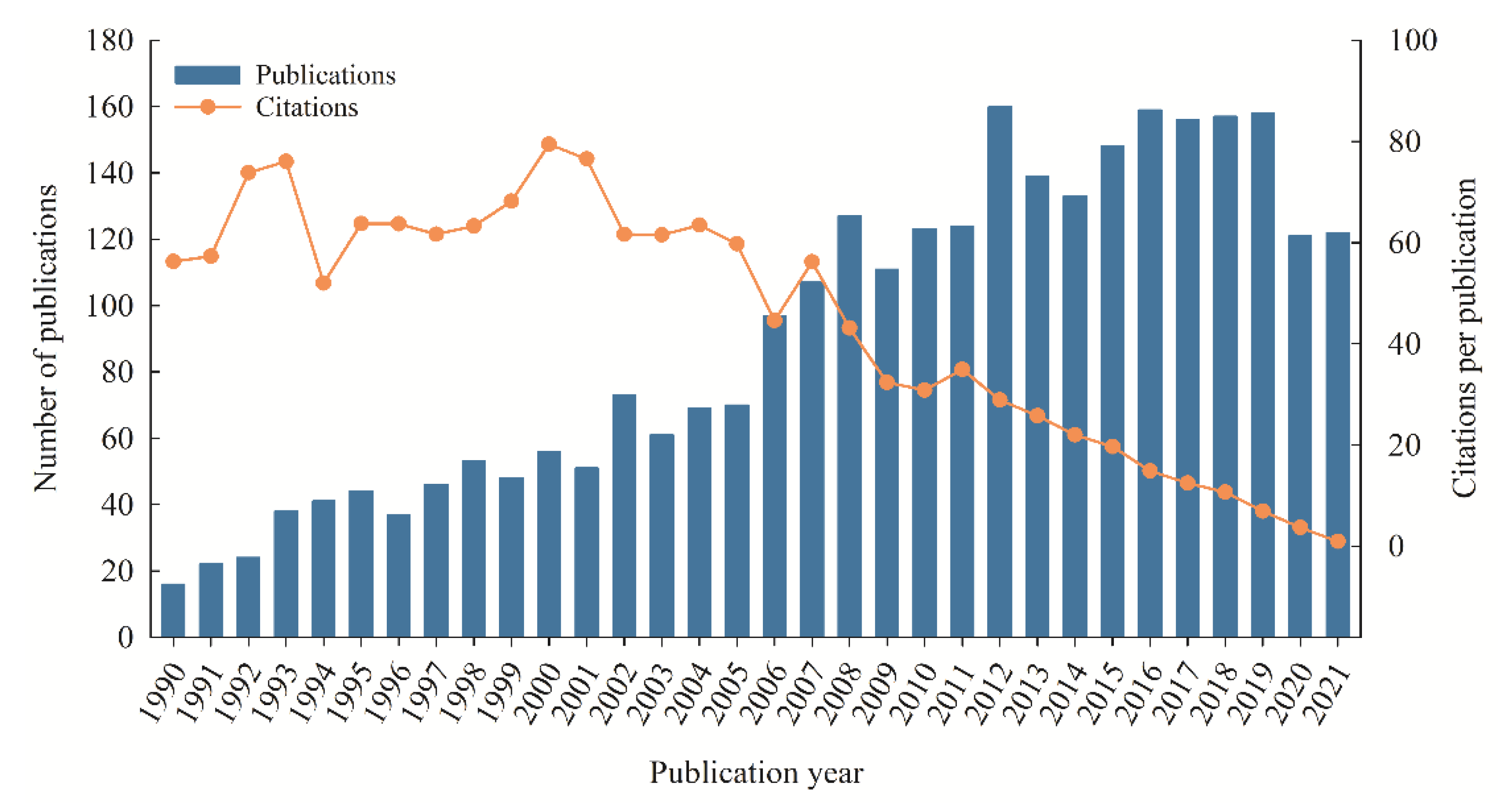
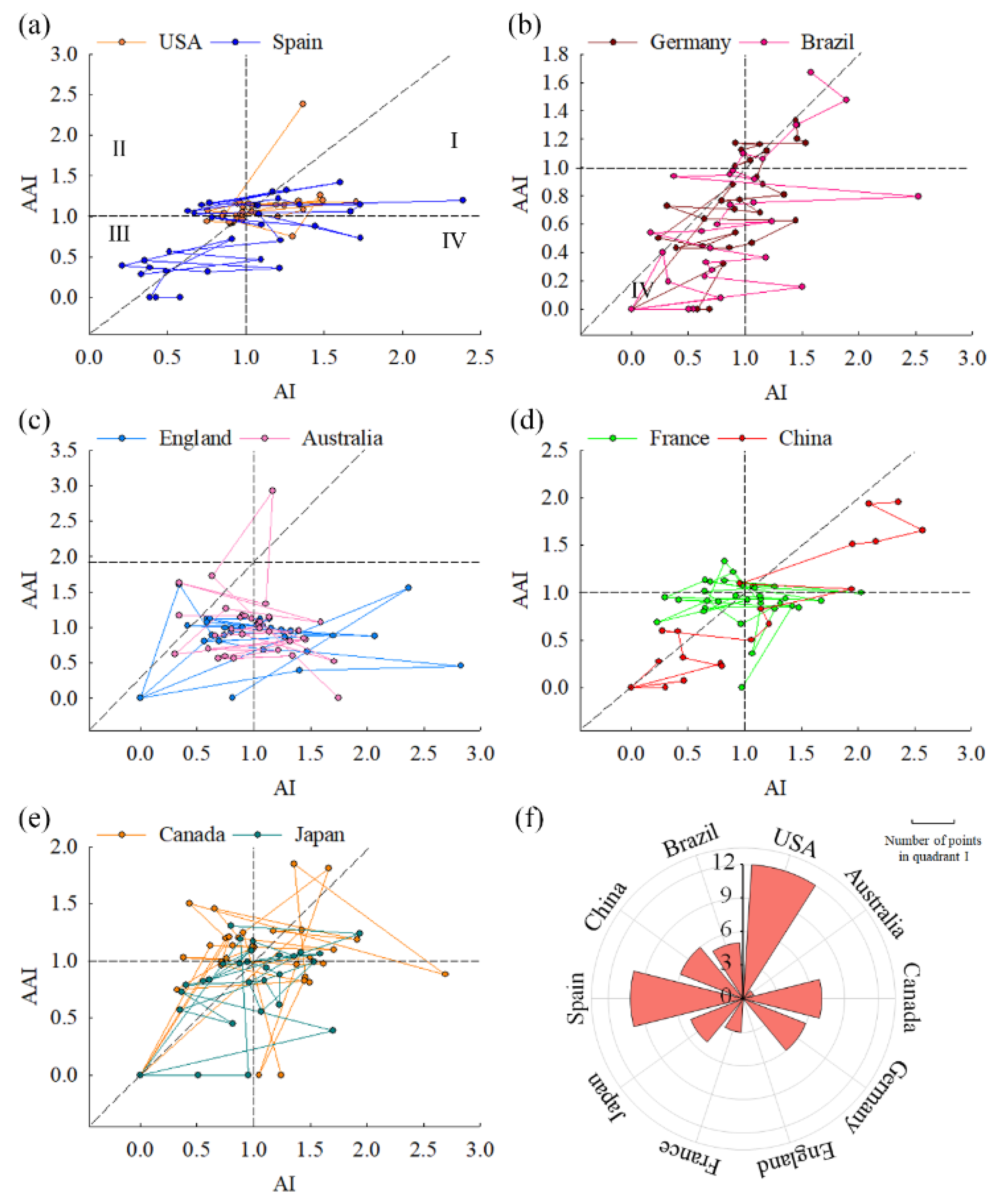
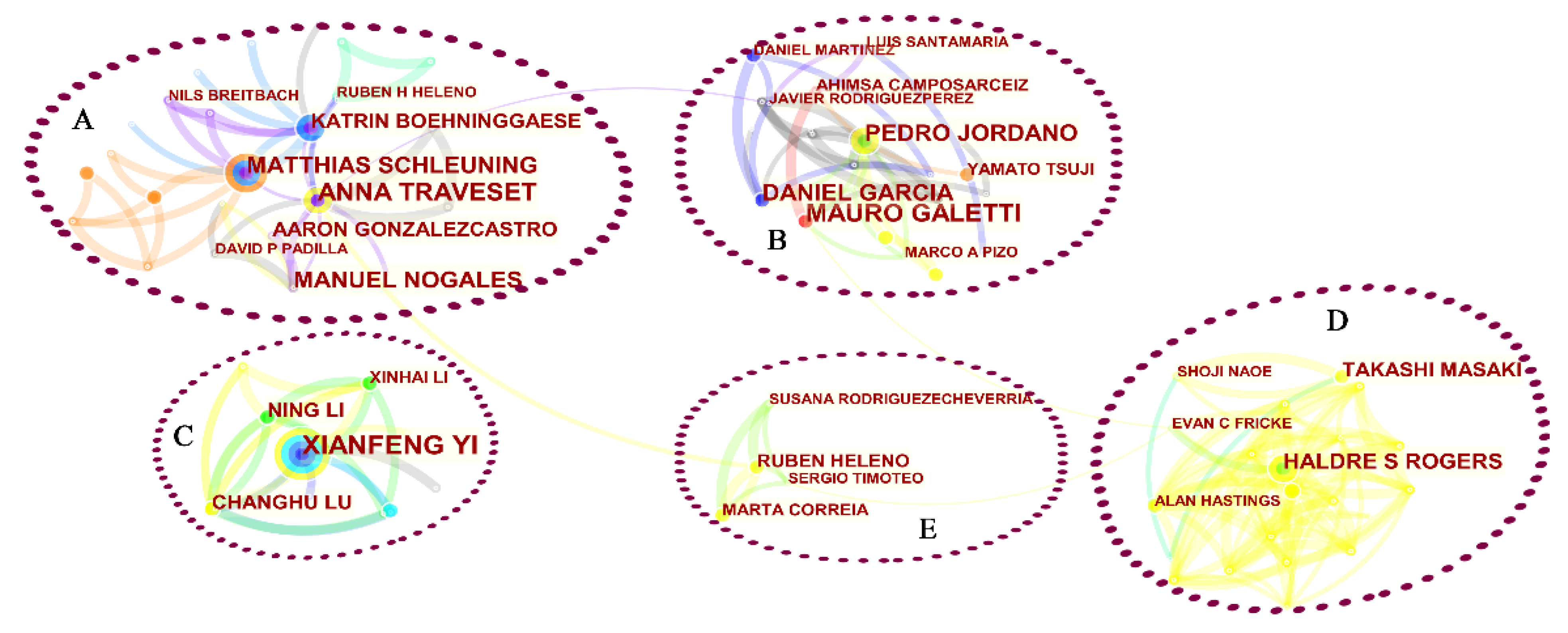
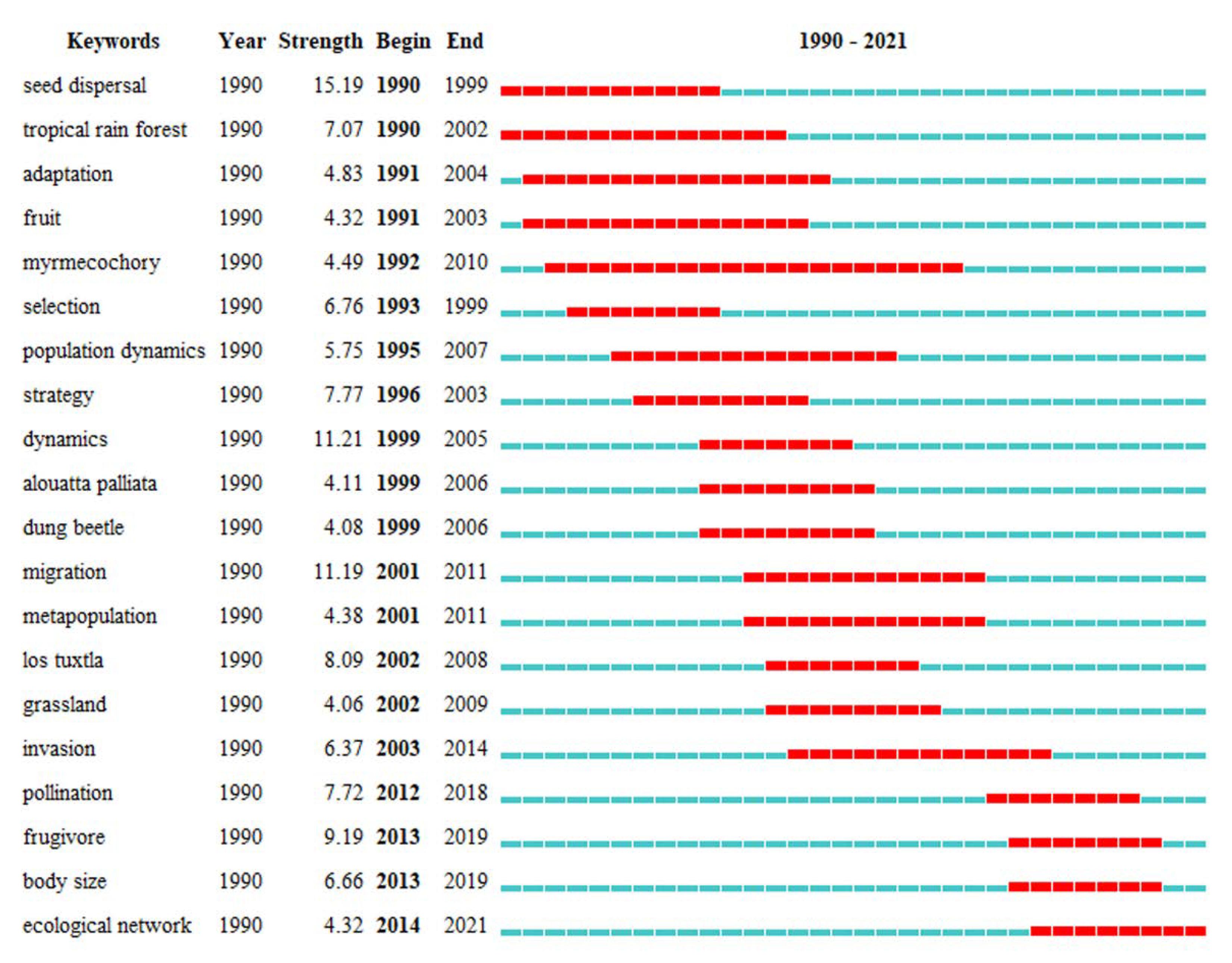
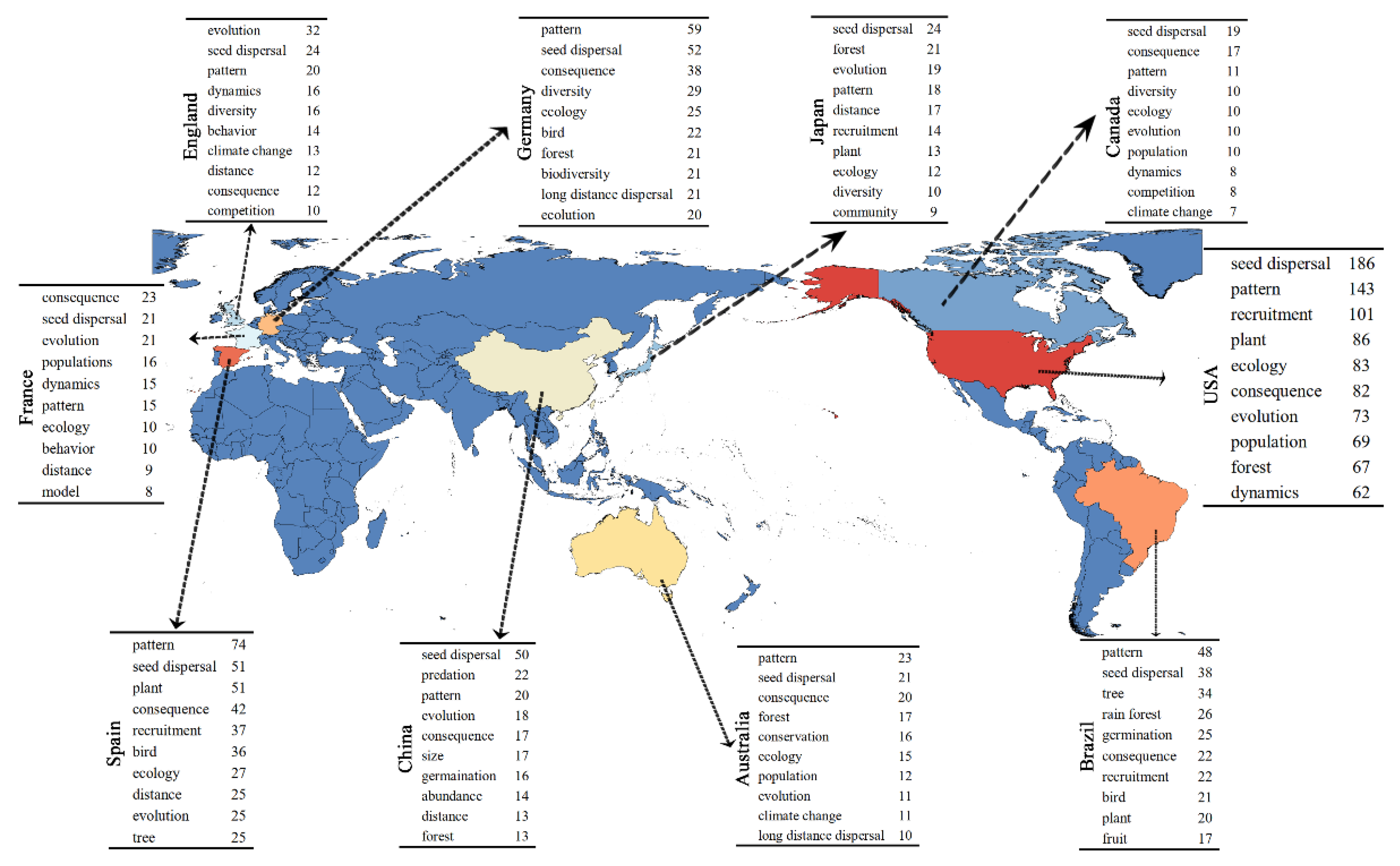
| Subject Category | 1990–2021 | % | Subject Category | 1990–2021 | % |
|---|---|---|---|---|---|
| Ecology | 1600 | 54.96 | Forestry | 206 | 7.08 |
| Plant Sciences | 484 | 16.63 | Multidisciplinary Sciences | 165 | 5.67 |
| Evolutionary Biology | 316 | 10.86 | Biology | 147 | 5.05 |
| Biodiversity Conservation | 226 | 7.76 | Environmental Sciences | 166 | 5.7 |
| Zoology | 218 | 7.49 | Genetics Heredity | 125 | 4.29 |
| Journals | Ps | % | TC a | TC/P b | H-Index c | IF d | Initial Year |
|---|---|---|---|---|---|---|---|
| Biotropica | 91 | 3.13 | 2511 | 27.59 | 32 | 2.508 | 1991 |
| Ecology | 79 | 2.71 | 5052 | 63.95 | 47 | 5.499 | 1990 |
| Oecologia | 77 | 2.65 | 3474 | 45.12 | 39 | 3.225 | 1992 |
| Oikos | 68 | 2.34 | 2053 | 30.19 | 29 | 3.903 | 1991 |
| Journal of Ecology | 66 | 2.27 | 3348 | 50.73 | 38 | 6.256 | 1993 |
| Plos One | 65 | 2.23 | 1247 | 19.18 | 19 | 3.24 | 2008 |
| Journal of Tropical Ecology | 62 | 2.13 | 1647 | 26.56 | 27 | 1.394 | 1990 |
| Plant Ecology | 60 | 2.06 | 1229 | 20.48 | 23 | 1.854 | 1997 |
| Molecular Ecology | 53 | 1.82 | 2493 | 47.04 | 30 | 6.185 | 1996 |
| Journal of Biogeography | 47 | 1.61 | 1712 | 36.43 | 24 | 4.324 | 1991 |
| Country | Ps | TC a | TC/P b | H-Index |
|---|---|---|---|---|
| USA | 934 | 27,291 | 29.22 | 99 |
| Spain | 312 | 7750 | 24.84 | 58 |
| Germany | 267 | 7709 | 28.87 | 54 |
| Brazil | 232 | 4530 | 19.53 | 41 |
| England | 224 | 9802 | 43.76 | 55 |
| Australia | 208 | 5556 | 26.71 | 45 |
| France | 186 | 5736 | 30.84 | 45 |
| China | 172 | 1997 | 11.61 | 25 |
| Canada | 149 | 4350 | 29.19 | 36 |
| Japan | 149 | 2019 | 13.55 | 26 |
| Institution | Country | Ps | TC a | TC/P b | H-Index |
|---|---|---|---|---|---|
| Consejo Superior de Investigaciones Científicas | Spain | 175 | 4749 | 27.14 | 45 |
| Centre National de la Recherche Scientifique | France | 125 | 3917 | 31.34 | 37 |
| University of California System | USA | 86 | 4279 | 49.76 | 36 |
| Chinese Academy of Sciences | China | 79 | 857 | 10.85 | 17 |
| CSIC Estacion Biologica de Donana EBD | Spain | 78 | 2454 | 31.46 | 32 |
| State University System of Florida | USA | 68 | 3228 | 47.47 | 34 |
| Smithsonian Institution | USA | 56 | 3668 | 65.50 | 27 |
| Institut de Recherche pour le Developpement | France | 54 | 2048 | 37.93 | 25 |
| Universidade de Sao Paulo | Brazil | 53 | 1102 | 20.79 | 20 |
| Universidade Estadual Paulista | Brazil | 53 | 1041 | 19.64 | 20 |
| Author | Journal/Book | Title | Year | TC |
|---|---|---|---|---|
| Nathan, R. | Trends in Ecology & Evolution | Spatial patterns of seed dispersal, their determinants and consequences for recruitment | 2000 | 1483 |
| Cain, M. L. | American Journal of Botany | Long-distance seed dispersal in plant populations | 2000 | 790 |
| Schupp, E. W. | Vegetatio | Quantity, quality and the effectiveness of seed dispersal by animals | 1993 | 671 |
| Clark, J. S. | Ecology | Seed dispersal near and far patterns across temperate and tropical forests | 1999 | 638 |
| Liljegren, S. J. | Nature | SHATTERPROOF MADS-box genes control seed dispersal in Arabidopsis | 2000 | 613 |
| Johnson, M.L. | Annual Review of Ecology Evolution & Systematics | Evolution of Dispersal: Theoretical Models and Empirical Tests Using Birds and Mammals | 1990 | 688 |
| Schupp, E. W. | The New phytologist | Seed dispersal effectiveness revisited: a conceptual review | 2010 | 648 |
| Mcpeek, M. A. | The American Naturalist | The evolution of dispersal in spatially and temporally varying environments | 1992 | 586 |
| Paradis, E. | Journal of Animal Ecology | Patterns of natal and breeding dispersal in birds | 2000 | 570 |
| Bakker, J. P. | Acta Botanica Neerlandica | Seed banks and seed dispersal: important topics in restoration ecology | 1996 | 492 |
Publisher’s Note: MDPI stays neutral with regard to jurisdictional claims in published maps and institutional affiliations. |
© 2022 by the authors. Licensee MDPI, Basel, Switzerland. This article is an open access article distributed under the terms and conditions of the Creative Commons Attribution (CC BY) license (https://creativecommons.org/licenses/by/4.0/).
Share and Cite
Liu, Y.; Li, C.; Liu, W.; Dong, Q. Trends in Global Research on Seed Dispersal: A Bibliometric Analysis. Sustainability 2022, 14, 16577. https://doi.org/10.3390/su142416577
Liu Y, Li C, Liu W, Dong Q. Trends in Global Research on Seed Dispersal: A Bibliometric Analysis. Sustainability. 2022; 14(24):16577. https://doi.org/10.3390/su142416577
Chicago/Turabian StyleLiu, Yuzhen, Caidi Li, Wentin Liu, and Quanmin Dong. 2022. "Trends in Global Research on Seed Dispersal: A Bibliometric Analysis" Sustainability 14, no. 24: 16577. https://doi.org/10.3390/su142416577
APA StyleLiu, Y., Li, C., Liu, W., & Dong, Q. (2022). Trends in Global Research on Seed Dispersal: A Bibliometric Analysis. Sustainability, 14(24), 16577. https://doi.org/10.3390/su142416577






